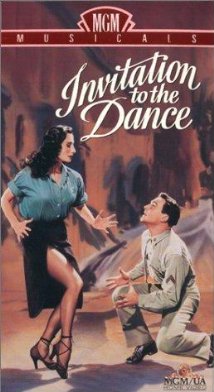
INVITATION TO THE DANCE
US, 1956, 93 minutes, Colour.
Gene Kelly, Igor Youskevich, Clare Sombert, Tamara Toumanova, Diana Adams, Tommy Rall, Andre Previn, Carol Haney, David Kasday.
Directed by Gene Kelly.
Invitation to the Dance is a film for specialist audiences, for those interested in different dance styles, from tap to ballet, and its development in films to the 1950s. It is also a film for fans of Gene Kelly.
The film was actually made at the end of 1952 and 1953, with the producers and MGM not confident about its box office success, it was not released until 1956 – and did not do particularly well, financially. However, for many it has a strong reputation and can still maintain audience interest.
It was a labour of love for Gene Kelly who did not initially intend to appear in all three segments but was urged by the producers. He directed the film – foreshadowing some of the other films he was to direct as he grew older, including Barbra Streisand in Hello Dolly. He also did the choreography, something he shared in such films as On the Town and Singin’ in the Rain with director, Stanley Damon.
The film is a showcase for Gene Kelly himself, his screen presence, his skills in dancing, with the touch of the acrobatic, in the first segment, Circus, as a marine in the second film, Ring Around a Rosy, in many ways reminiscent of the Slaughter on 10th Avenue, and as a sailor in Sinbad the Sailor, a variety of dancing styles with the young boy, David Kasday, who plays the Genie, and a lengthy cartoon sequence with a Princess and two Arabian swordsman – echoes of his dancing with Tom and Jerry in Anchors Aweigh.
The Circus has quite some pathos, showing lovers, with the Clown pining for the girl, offering her flowers and almost attracting her, but she is distracted by some spectacular walking and gymnastics on the tightrope. There is an interlude where the Clown holds many props and these are taken by fellow-dancers and there are some exuberant performances by the ensemble. Finally, the Clown goes on to the tightrope but falls on a red cloak, symbolising blood, and dies
The second segment, Ring Around Rosy, is a contemporary story, with a large cast initially introduced, with a number of dance names including Tamara Tamanouva and Belita. Kelly himself takes a rather minor role as a marine. The setting is affluent contemporary society, at clubs, with a range of well-dressed and chattering guests, a crooner, and a series of passing on of a bracelet to a number of characters and its finally returning to the initial giver. There are some ballet pieces as well as tap dancing and Kelly partners a streetwalker.
The third sequence is Sinbad the Sailor, with Roger Eden’s adapting the music of Rimski- Korsakoff. The scene is the Arabian Nights with Carol Haney as Scheherezade. Kelly portrays a contemporary sailor, being persuaded to buy many items in the marketplace but the authorities making him pay for a lamp which has been stolen. Each times he rubs it, a genie appears, and a Princess, then a painting into which Kelly and the genie go, which then becomes an elaborate animation sequence, the man and the boy dancing, the boy following the movements of the man, then with the Princess, then with the Arabian swordsman. It is an entertaining tour-de-force of dance and animation.
As has been said, a film for a specialist audience interested in dance and Gene Kelly.